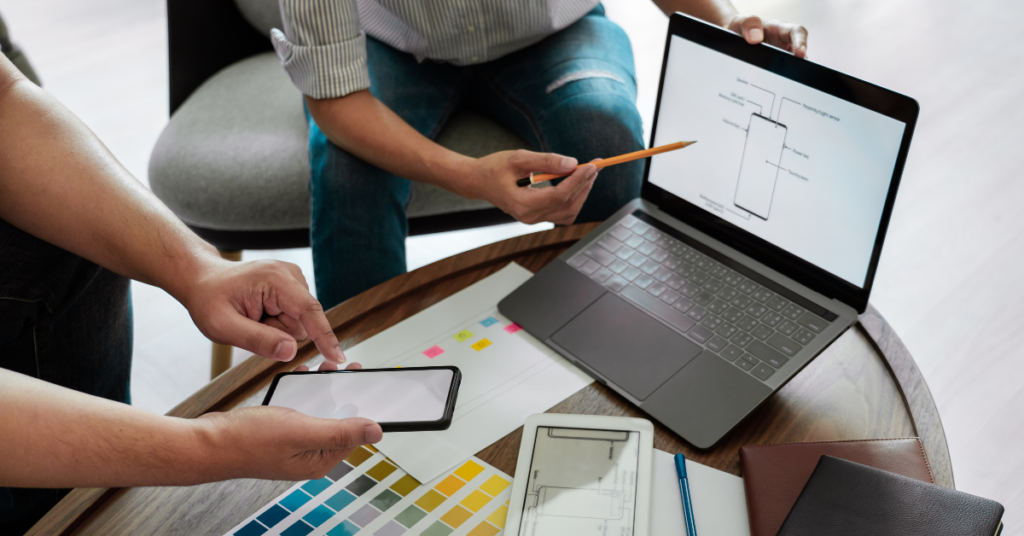A 7-Step Guide to Drive Success by Harmonizing Product Manager and Designer Roles

When it comes to successful project outcomes, the product manager and designer collaboration is more than just a partnership. Let us dive into the dynamics of how designers and product managers work together, emphasizing the importance of their relationship in designing and managing products effectively.
In this blog, we shall discuss the following:
- Understanding Roles and Responsibilities
- Alignment of Goals
- Effective Communication
- Balancing Creativity and Practicality
- Early Involvement and Collaboration
- Conflict Resolution
- Recognition of Expertise
Understanding Roles and Responsibilities
In the collaborative world of project development, product manager and designer roles are distinct yet interdependent. Designers, with their keen eye for aesthetics and user experience, bring a creative vision that is essential for the product’s appeal. They delve into the nuances of user interaction, ensuring that the product is not only functional but also engaging. On the other hand, product managers act as strategic orchestrators. Their role is to align the project with the overarching business goals, making sure that every step taken by the team contributes to the broader objectives of the company.
This strategic planning by the product manager and designer is crucial for the project’s success. Hence, a clear understanding of these responsibilities is not just beneficial; it’s necessary for efficient collaboration. When both parties appreciate and respect each other’s roles, it sets the stage for effective teamwork and successful project outcomes.
ALSO READ: What is a PMO in Project Management: A Comprehensive 2024 Guide
Alignment of Goals
1. Shared Vision for Success
The alignment of goals between product manager and designer roles creates a shared vision for the project’s success. This shared vision guides every decision and action, ensuring that both parties work towards a common objective.
For instance, in a tech startup, the product manager and designer might collaborate on a new app. The product manager focuses on market analysis and feature prioritization; the designer concentrates on user interface and experience. Together, they could develop a shared vision that combines market viability with user-centric design. This guides the app towards success in a competitive market.
2. Enhancing User Satisfaction
A common goal for both product manager and designer is enhancing user satisfaction. This involves creating a product that not only meets but exceeds user expectations in terms of functionality and design.
3. Streamlining Functionality
Another shared goal is streamlining the functionality of the product. Designers and product managers work together to ensure that the product is aesthetically pleasing, functional, and easy to use.
Take the development of a smart home device, for example; the product manager and designer must ensure the device is not only sleek and modern but also easy to set up and use.
4. Balancing Creative and Strategic Goals
Balancing the creative goals of the designer with the strategic goals of the product manager is key here. This balance ensures that the product is both innovative and aligned with business objectives.
A case in point could be the launch of a new line of sustainable clothing. The designer might propose innovative, eco-friendly materials and designs while the product manager assesses market trends and cost implications. Together, they balance the creative aspiration of making a fashion statement with the strategic goal of affordability and market appeal.
5. Coherent Decision-Making
When goals are aligned, decision-making becomes more coherent and efficient. This leads to a smoother project flow and a more successful outcome.
ALSO READ: What is Project Management? Meaning, Approaches, and Career Prospects
Effective Communication
Effective communication is the backbone for an excellent collaboration between product manager and designer. Miscommunication, or lack thereof, can derail a project, leading to delays, frustration, and suboptimal results. To mitigate this, regular meetings and clear, concise documentation are essential. These practices help in keeping both parties informed and aligned, ensuring that everyone is on the same page. When designers and product managers communicate effectively, it reduces misunderstandings and fosters a collaborative environment conducive to innovation and problem-solving. They use strategies like clear documentation and using prototypes to visualize concepts. ,.
Balancing Creativity and Practicality
The relationship between a designer’s creativity and a product manager’s practicality is a delicate dance. It is pivotal to understand how do designers and product managers work together. Designers often push the boundaries of innovation, while product managers need to consider constraints like budget, resources, and timelines. Finding a balance for creativity to thrive without compromising the project’s practical aspects is a key challenge.
Let’s take the example of a mobile app project. The designer envisions incorporating advanced Augmented Reality (AR) features. Here, the product manager might oppose this, citing a limited budget and tight timeline. They will have to compromise by launching a basic version first, followed by updates to add AR features later.
Similarly, when it comes to a new organic food product line, the designer might propose an innovative, eco-friendly packaging design. The product manager, however, could raise concerns about high costs and sourcing time. They might eventually opt for more readily available yet eco-friendly materials.
ALSO READ: Project Management vs Program Management
Early Involvement and Collaboration
Advocating for early involvement in designing and managing products in the project lifecycle is critical. When these roles are engaged from the outset, it ensures a more integrated approach to the project. This paves the way for a seamless workflow and a unified vision. There are numerous success stories where early collaboration between the product manager and designer led to innovative and successful projects.
Success Story 1: Airbnb’s User Experience Overhaul
Airbnb’s redesign in the early 2010s is a classic example of successful collaboration between product manager and designer roles. The product managers conducted extensive market research and user feedback analysis. On the other side, the designers focused on creating a more intuitive and engaging user interface. This collaboration led to a significant overhaul of the Airbnb platform, making it more user-friendly and visually appealing.
Success Story 2: Nike’s Sustainable Product Line
Nike’s move towards sustainable product design involved close collaboration between product managers and designers. The product managers researched sustainable materials and market trends, while designers incorporated these materials into stylish and functional athletic wear. This joint effort led to the successful launch of Nike’s sustainable product line. It was well-received internationally for both its environmental consciousness and design innovation.
ALSO READ: Why Is Quality Planning Important in Project Management?
Conflict Resolution
It is not always easy to maintain harmony in product and design endeavors. Conflicts are inevitable in the collaborative process. Here are some ways to resolve the same:
1. Identifying Sources of Conflict
It is natural for conflicts to arise in the collaborative journey between designers and product managers. Identifying these conflicts early on, whether they stem from differing priorities or perspectives, is crucial. Moreover, understanding the root cause enables both parties to address issues before they escalate, helping them maintain a healthy working relationship.
2. Open Dialogue for Resolution
Open dialogue is a key strategy in resolving conflicts between product managers and designers. Encouraging honest and respectful communication allows both parties to express their concerns and viewpoints. In essence, transparency is essential for finding common ground and moving forward constructively.
3. Compromise and Collaboration
Compromise plays a significant role in conflict resolution. When designers and product managers are willing to meet halfway, it demonstrates a commitment to the project’s success over individual egos. This collaborative spirit is vital for overcoming obstacles and maintaining the project’s momentum.
4. Maintaining a Positive Working Relationship
Maintaining a positive working relationship between designers and product managers is essential as it helps keep conflicts at bay. In fact, fostering an environment of mutual respect and understanding is integral for ensuring a productive collaboration.
5. Strategies for Constructive Conflict Resolution
Implementing strategies like regular conflict resolution meetings, setting clear communication guidelines, and establishing a culture of feedback can be effective in managing conflicts. These strategies ensure that both designers and product managers work together harmoniously, even in challenging situations.
ALSO READ: Building the Perfect Resume for a Project Manager Role
Recognition of Expertise
Recognizing each other’s expertise is crucial in collaborative projects. When product managers and designers value each other’s skills, effective teamwork is fostered. This mutual respect leads to an environment where innovative ideas thrive. Appreciating the unique skills and perspectives of both roles enhances team dynamics, resulting in more effective and creative project outcomes. When each party feels their expertise is recognized, they contribute their best, boosting project success.
For instance, in an automotive interface design project, the product managers provide safety and functionality insights while the designers focus on aesthetics. This partnership results in a user-friendly, safe, and visually appealing dashboard, increasing sales and customer satisfaction.
Similarly, in a green building project, the project manager’s knowledge of sustainable practices, when combined with the designer’s innovative approach, can lead to a cost-effective, environmentally sustainable, and aesthetically pleasing building.
ALSO READ: Project Management Certification Course: Importance and Eligibility Criteria
In conclusion, collaboration between the product manager and designer is pivotal for the success of any project. By understanding each other’s roles, aligning goals, communicating effectively, balancing creativity with practicality, etc., these professionals can achieve remarkable outcomes. For those interested in mastering these dynamics, consider exploring Emeritus’ project management courses and be at the forefront of driving organizational success.
Write to us at content@emeritus.org





